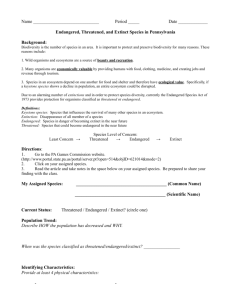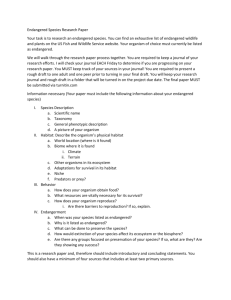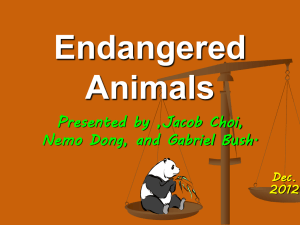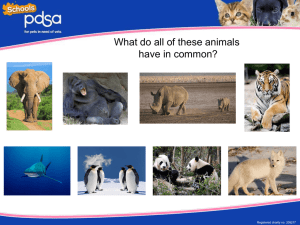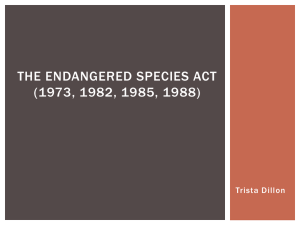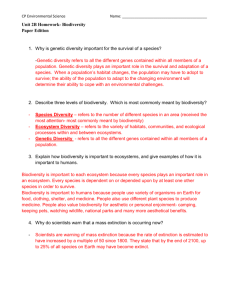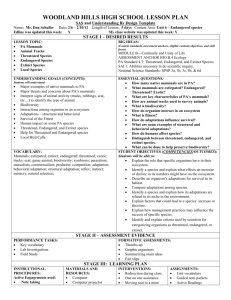Chapter 10 Biodiversity Notes and Q and A
advertisement
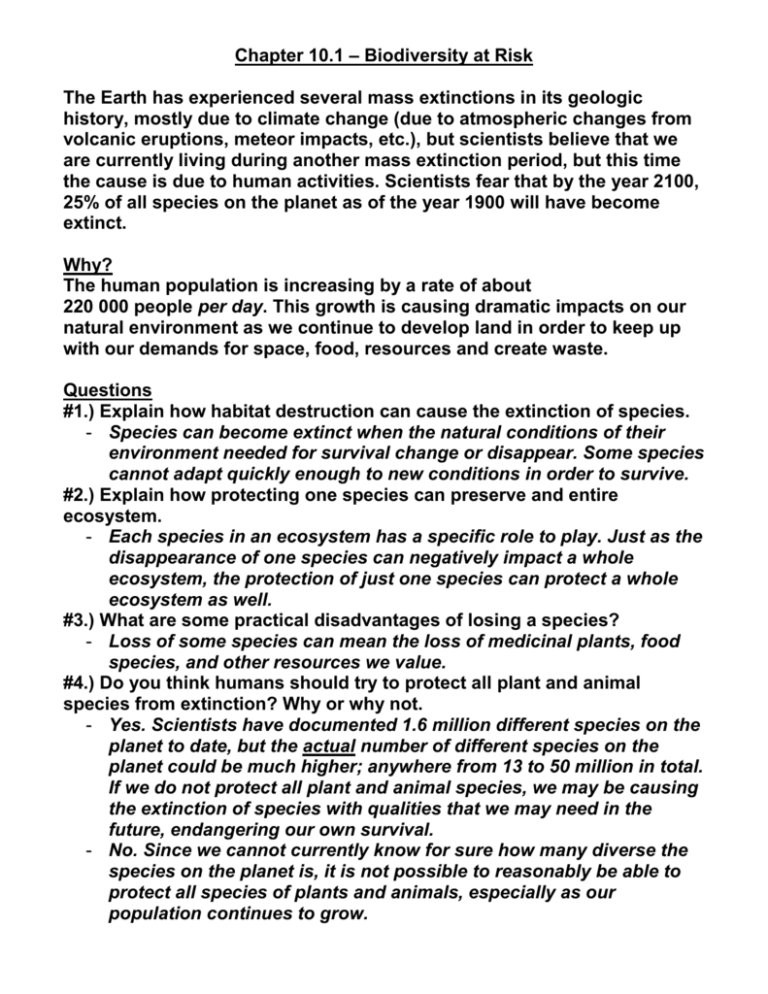
Chapter 10.1 – Biodiversity at Risk The Earth has experienced several mass extinctions in its geologic history, mostly due to climate change (due to atmospheric changes from volcanic eruptions, meteor impacts, etc.), but scientists believe that we are currently living during another mass extinction period, but this time the cause is due to human activities. Scientists fear that by the year 2100, 25% of all species on the planet as of the year 1900 will have become extinct. Why? The human population is increasing by a rate of about 220 000 people per day. This growth is causing dramatic impacts on our natural environment as we continue to develop land in order to keep up with our demands for space, food, resources and create waste. Questions #1.) Explain how habitat destruction can cause the extinction of species. - Species can become extinct when the natural conditions of their environment needed for survival change or disappear. Some species cannot adapt quickly enough to new conditions in order to survive. #2.) Explain how protecting one species can preserve and entire ecosystem. - Each species in an ecosystem has a specific role to play. Just as the disappearance of one species can negatively impact a whole ecosystem, the protection of just one species can protect a whole ecosystem as well. #3.) What are some practical disadvantages of losing a species? - Loss of some species can mean the loss of medicinal plants, food species, and other resources we value. #4.) Do you think humans should try to protect all plant and animal species from extinction? Why or why not. - Yes. Scientists have documented 1.6 million different species on the planet to date, but the actual number of different species on the planet could be much higher; anywhere from 13 to 50 million in total. If we do not protect all plant and animal species, we may be causing the extinction of species with qualities that we may need in the future, endangering our own survival. - No. Since we cannot currently know for sure how many diverse the species on the planet is, it is not possible to reasonably be able to protect all species of plants and animals, especially as our population continues to grow. Chapter 10.2 – Biodiversity and Public Policy As of 2007, the purpose of Canada’s Endangered Species Act specifies the following: 1. To identify species at risk based on the best available scientific information, including information obtained from community knowledge and aboriginal traditional knowledge. 2. To protect species that are at risk and their habitats, and to promote the recovery of species that are at risk. 3. To promote stewardship activities to assist in the protection and recovery of species that are at risk. In spite of this Act, there are currently 631 species that are endangered in Canada today, including plants, birds and fish according to Nature Canada. Questions #1.) What is the difference between an endangered species and a threatened species? - Endangered species are species whose numbers have declined to the point that they may become extinct if not protected. - Threatened species are species that are likely to become endangered if they are not protected. #2.) Why can’t some species survive on small plots of land? - Most species require a large range of land to obtain adequate food supplies, to find a suitable mate and to rear young. Also, if left to a small plot of land, unusually harsh weather or a blight of some kind can easily wipe out the entire species. #3.) Do you think it is reasonable for an expensive dam project to be stopped by the discovery of an endangered species that would be threatened by the dam? Why or why not? - Yes. People should find ways to be more efficient with water or to use alternate sources of energy instead of destroying so much habitat and endangering species because creating a dam might seem like a simpler solution for human needs. - No. Human needs are growing as does our population. Even with water efficiency and alternate sources of energy, we may still need to dam areas. Arguably, this is part of Darwin’s law of survival for the fittest. Chapter 10.3 – The Future of Biodiversity In order to promote biodiversity into the future, human will need to slow their development on the land and consider practices such as continuing to save individual species under policies such as the Endangered Species Act, but also through: - Captive-Breeding Programs (breeding animals in captivity to promote reproduction, then ideally release them back into the wild) - Use of Botanical Gardens (these specialized gardens are concentrated areas of species diversity to help preserve rare or endangered species of plants) - Use of Germ-Plasm Banks (these are special laboratories where genetic material of plants that includes their reproductive cells can be stored – such as seeds, sperm and eggs, in temperature and humidity controlled environments that can allow them to survive for years). - Using a Whole Ecosystem Approach (protecting entire ecosystems) By concentrating on protecting entire ecosystems we can save the greatest number of species, not only those on endangered lists, which considering that we don’t know how many species there actually are on the planet, can be of most benefit. The health of the entire Biosphere depends on the preservation of combined ecosystems How? Through establishing conservation areas and protected land areas, especially in “hot zones” that contain a large number of endangered species that are found nowhere else on the planet (California, Ecuador, Chile, Brazil, Ivory Coast, South Africa, Tanzania, Madagascar, Sri Lanka, Philippines, etc.) Questions #1.) Which of the ways to save individual species involves the preservation of only part of the species? - Germ-Plasm Banks #2.) Why are some conservationists beginning to concentrate on protecting entire ecosystems rather than individual species? - Many species can be protected, known and unknown, not just those that are listed as endangered, which contributes to the overall health of the Earth’s Biosphere. #3.) The Biodiversity “hot spots” share several characteristics other than endangered species. What are they? Refer to map on p. 269. - They are located in tropical regions close to the Equator, often on islands and located mostly in developing countries. Sadly, these countries can often least financially afford conservation policies.


